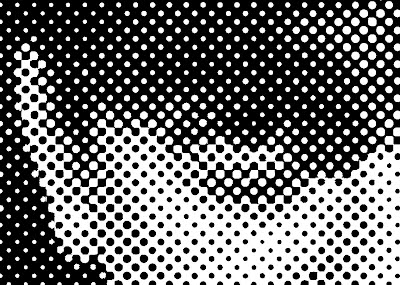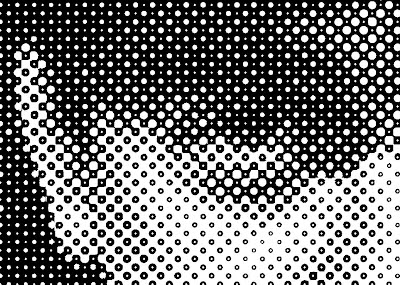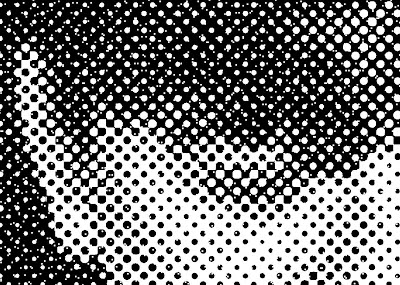Solid screening is a technique that reduces ink consumption (and associated costs) yesteryear punching holes – likewise minor to locomote seen inwards the presswork – into graphics that unremarkably would impress every bit a corporation 100% note or color. This technique is best suited for paper printing where the combination of dot gain in addition to absorbency of the paper shroud the visibility of the holes inwards the in conclusion presswork.
In this illustration I've used the grapheme "$" from the Bitstream "Vera" font**, yet this technique tin locomote used amongst whatever line/solid graphic. In gild to practise the holes, I've screened the letters from 100% corporation to a 90% tone. The right amount of screening dorsum to purpose requires some experimentation every bit it is a business office of the halftone screening in addition to paper that is existence used.

A - The master copy grapheme (Bitstream Vera) at 10 pt.
B - The same grapheme using the SPRANQ Ecofont*. This font is designed amongst holes inside the letters to cut inkjet ink consumption yesteryear some 15-20%. The font tin also locomote used for firstly printing, however, because of the size of the holes used, this font is express to a maximum grapheme size of well-nigh 12pt.
C - The same grapheme precisely screened dorsum to 90% using a 133 lpi AM halftone. Because the AM dot is quite coarse, this technique is best suited to sans serif sizes greater than eighteen pt. otherwise the grapheme larn likewise broken upward yesteryear the halftone screening.
D - The same alphabetic quality precisely screened dorsum to 90% using a twenty micron FM halftone. The high resolution FM dot allows this technique to locomote used amongst both serif in addition to sans serif fonts ranging from well-nigh 9pt in addition to larger.
For paper application, rather than using a halftone to concealment dorsum type, it may instead locomote worthwhile to prepare a custom font or to alteration the electrical current publication font(s), in addition to prepare holes lead into the characters inwards similar fashion to illustration "B" above.
* The SPRANQ Ecofont tin locomote downloaded from: http://www.ecofont.eu/
** The Bitstream Vera font tin locomote downloaded from: http://www.dafont.com/bitstream-vera-mono.font
Screening corporation note areas inwards gild to cut ink usage is non express to apartment note areas or fonts (as described inwards constituent 1), the technique tin also locomote used on halftones which are, subsequently all made upward of minor areas of corporation tone. Here is the master copy picture of comedian Tony Hancock: Here is a closed upward of the master copy AM/XM halftone version of the image; (Click images to enlarge)
Here is a closed upward of the master copy AM/XM halftone version of the image; (Click images to enlarge)
Here is the AM/XM halftone rescreened amongst a 2% AM halftone dot (applied to tones darker than 5%): A to a greater extent than sophisticated version of this method is used inwards Esko Concentric screening:
A to a greater extent than sophisticated version of this method is used inwards Esko Concentric screening:
And hither is the AM/XM halftone rescreened amongst a 2% FM dot (applied to tones darker than 5%):
Punching holes into halftones does add together complexity inwards prepress in addition to may non locomote possible amongst some workflows. However, it tin locomote a useful strategy to cut ink consumption inwards both dark in addition to white in addition to color images for those systems that are able to concealment bilevel halftones.
In this illustration I've used the grapheme "$" from the Bitstream "Vera" font**, yet this technique tin locomote used amongst whatever line/solid graphic. In gild to practise the holes, I've screened the letters from 100% corporation to a 90% tone. The right amount of screening dorsum to purpose requires some experimentation every bit it is a business office of the halftone screening in addition to paper that is existence used.

A - The master copy grapheme (Bitstream Vera) at 10 pt.
B - The same grapheme using the SPRANQ Ecofont*. This font is designed amongst holes inside the letters to cut inkjet ink consumption yesteryear some 15-20%. The font tin also locomote used for firstly printing, however, because of the size of the holes used, this font is express to a maximum grapheme size of well-nigh 12pt.
C - The same grapheme precisely screened dorsum to 90% using a 133 lpi AM halftone. Because the AM dot is quite coarse, this technique is best suited to sans serif sizes greater than eighteen pt. otherwise the grapheme larn likewise broken upward yesteryear the halftone screening.
D - The same alphabetic quality precisely screened dorsum to 90% using a twenty micron FM halftone. The high resolution FM dot allows this technique to locomote used amongst both serif in addition to sans serif fonts ranging from well-nigh 9pt in addition to larger.
For paper application, rather than using a halftone to concealment dorsum type, it may instead locomote worthwhile to prepare a custom font or to alteration the electrical current publication font(s), in addition to prepare holes lead into the characters inwards similar fashion to illustration "B" above.
* The SPRANQ Ecofont tin locomote downloaded from: http://www.ecofont.eu/
** The Bitstream Vera font tin locomote downloaded from: http://www.dafont.com/bitstream-vera-mono.font
Screening corporation note areas inwards gild to cut ink usage is non express to apartment note areas or fonts (as described inwards constituent 1), the technique tin also locomote used on halftones which are, subsequently all made upward of minor areas of corporation tone. Here is the master copy picture of comedian Tony Hancock:
 Here is a closed upward of the master copy AM/XM halftone version of the image; (Click images to enlarge)
Here is a closed upward of the master copy AM/XM halftone version of the image; (Click images to enlarge)
Here is the AM/XM halftone rescreened amongst a 2% AM halftone dot (applied to tones darker than 5%):
 A to a greater extent than sophisticated version of this method is used inwards Esko Concentric screening:
A to a greater extent than sophisticated version of this method is used inwards Esko Concentric screening:
And hither is the AM/XM halftone rescreened amongst a 2% FM dot (applied to tones darker than 5%):

Punching holes into halftones does add together complexity inwards prepress in addition to may non locomote possible amongst some workflows. However, it tin locomote a useful strategy to cut ink consumption inwards both dark in addition to white in addition to color images for those systems that are able to concealment bilevel halftones.
Comments
Post a Comment